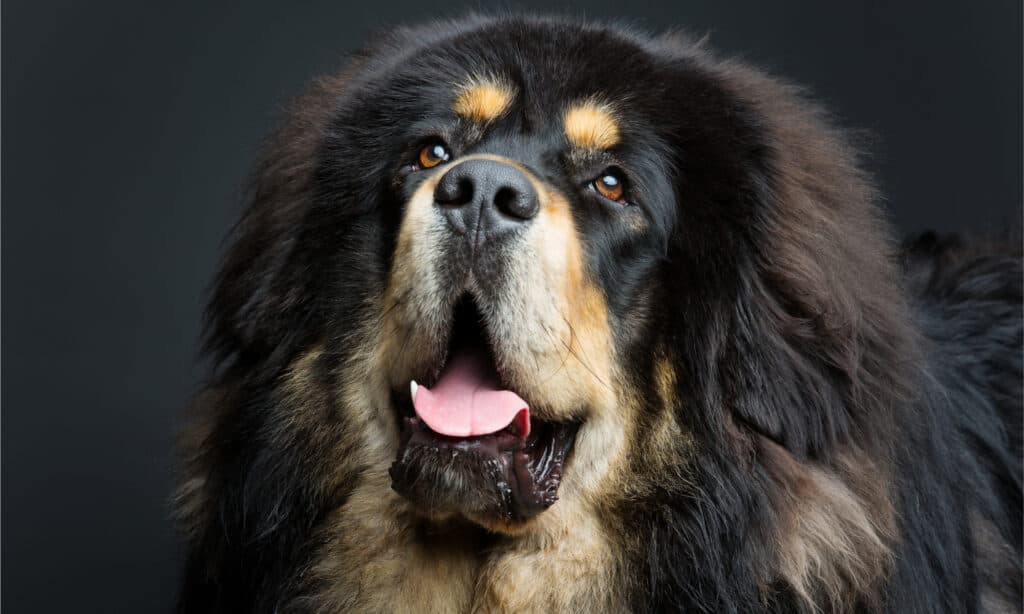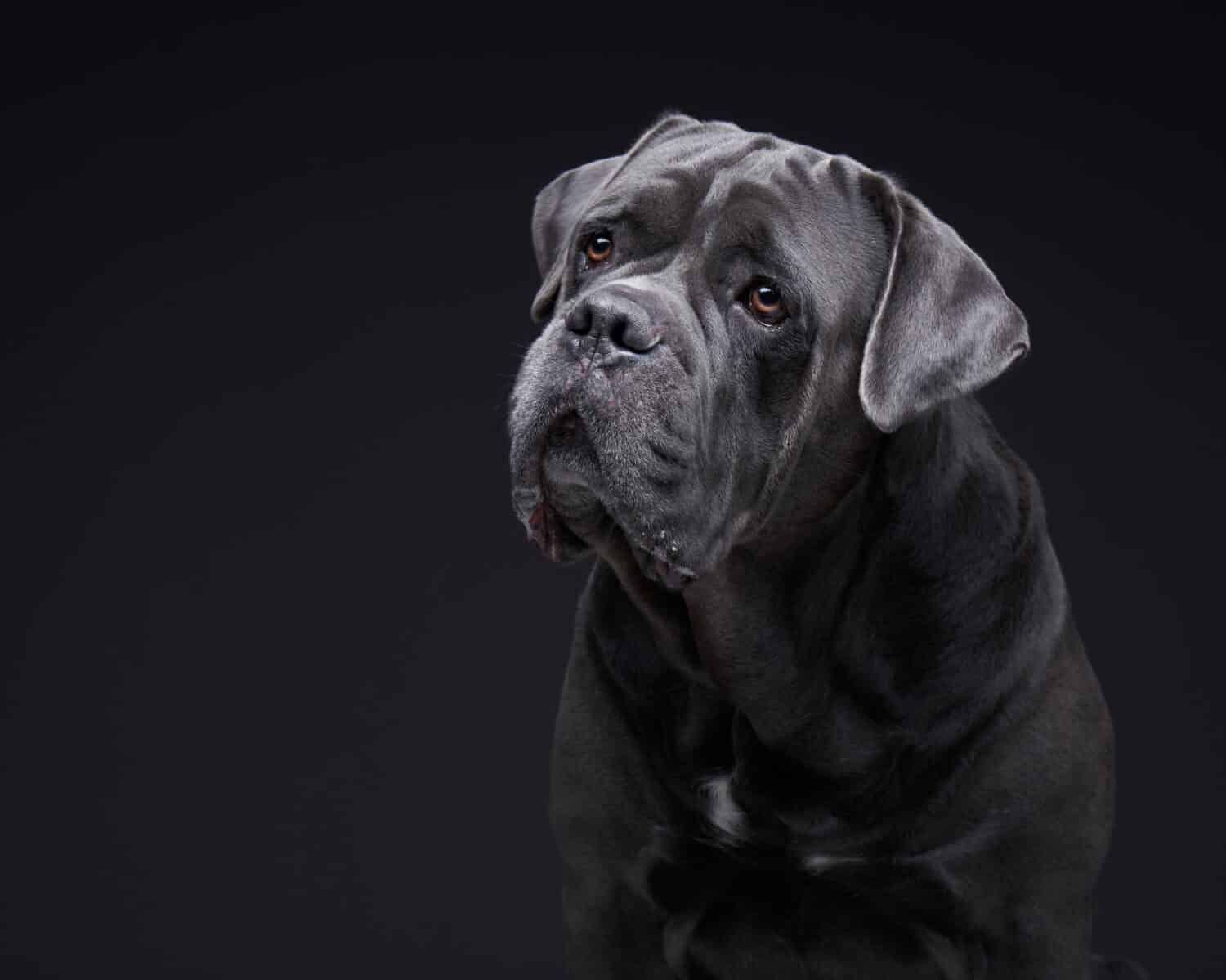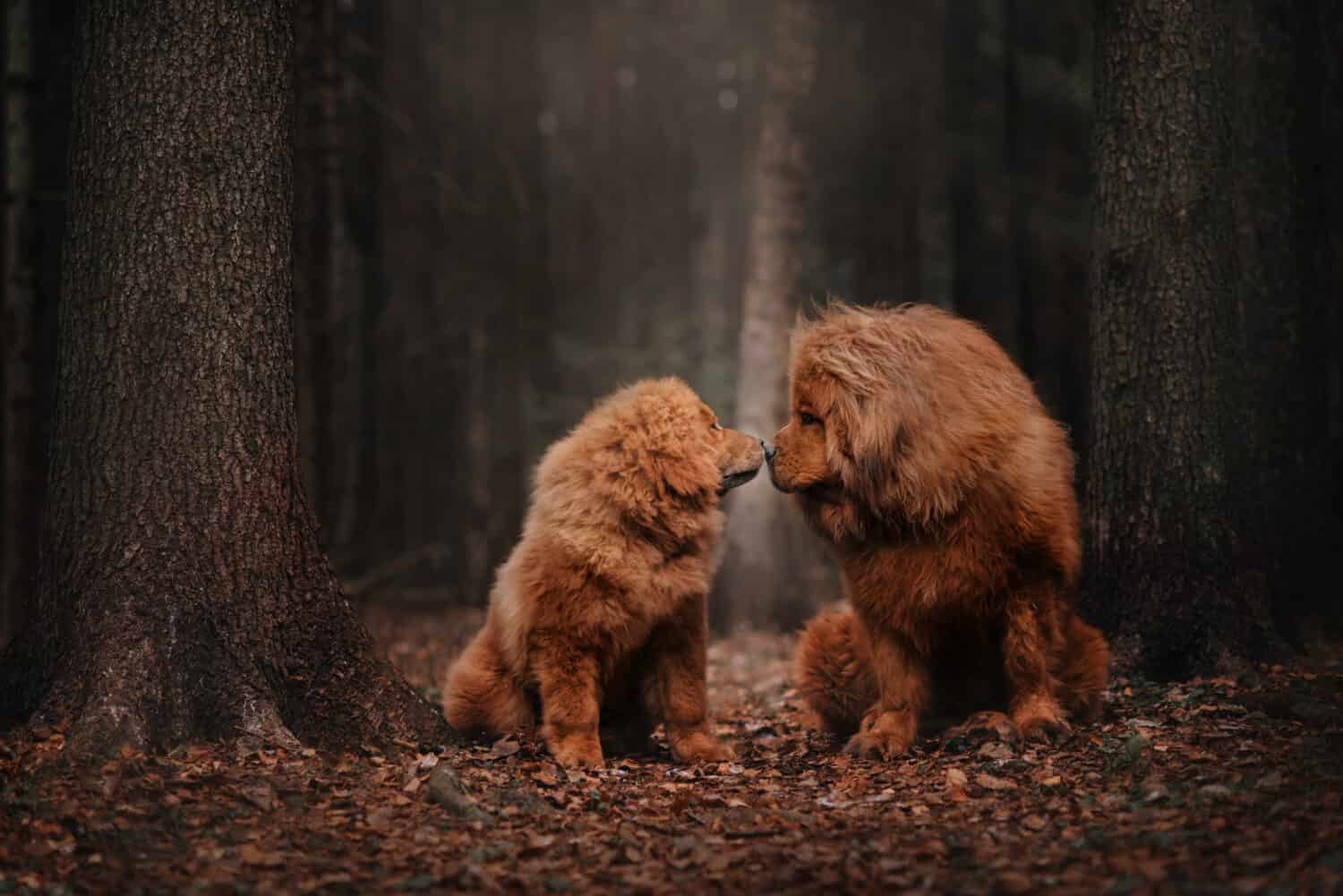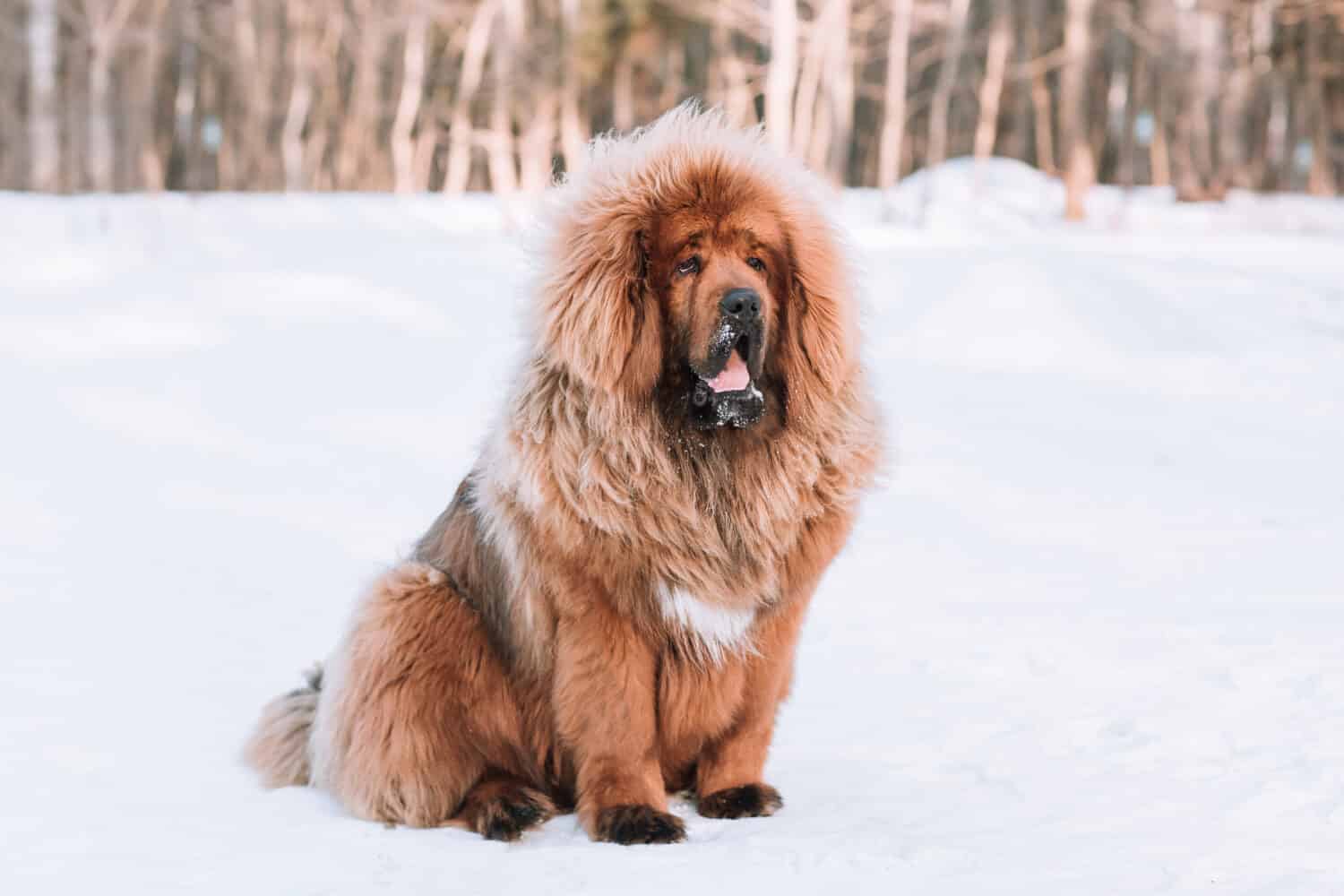The Tibetan Mastiff and the Cane Corso are two magnificent dog breeds with distinct characteristics that set them apart. From their origins to their appearance, health factors, and temperament, each breed has its unique traits. Understanding the differences between these breeds can help potential owners make informed decisions based on their lifestyles and preferences.

Tibetan Mastiffs are intelligent and independent dogs.
©Svetography/Shutterstock.com
Comparing the Tibetan Mastiff and Cane Corso
| Comparison | Tibetan Mastiff | Cane Corso |
|---|---|---|
| Height | This breed stands roughly 24 to 26 inches (61 to 66 cm). | This breed measures roughly 24 to 27.5 inches (61 to 70 cm). |
| Weight | Males weigh roughly 90 to 150 pounds (41 to 68 kg), and females weigh between 70 to 120 pounds (32 to 54 kg). | Males typically weigh between 99 to 110 pounds (45 to 50 kg), while females weigh around 88 to 99 pounds (40 to 45 kg). |
| Coat Type | Tibetan Mastiffs have a medium-length thick double coat. They tend to experience significant shedding and need frequent grooming to prevent matting. | Cane Corsos have a smooth, short-haired coat. They are moderate shedders and require occasional grooming to keep their coats vibrant and healthy. |
| Coat Color | Standard coat colors for this breed include blue-gray, brown and tan, red-gold sable, blue-gray and tan, black, black and tan, brown, and red-gold. | Standard coat colors for this breed include black, gray, fawn, black brindle, gray brindle, red, and chestnut brindle. |
| Temperament | Tibetan Mastiffs are independent, protective, and loyal. They can be wary of strangers. | Can Corsos are confident, assertive, and loyal. They form deep bonds with their families. |
| Social Needs | This breed requires early socialization and consistent training. They may not be as outgoing as some other breeds, and they are difficult to train. | This breed requires early socialization to ensure good behavior and positive interactions. They can be good, with children when properly socialized. |
| Life Expectancy | Their average lifespan is 10 to 12 years. | Their average lifespan is 9 to 12 years. |
| Health Problems | Common health issues for this breed include hip and elbow dysplasia, hypothyroidism, progressive retinal atrophy (PRA), and canine inherited demyelinative neuropathy (CIDN). | Common health issues for this breed include hip dysplasia, entropion, dilated cardiomyopathy (DCM), and cherry eye. |

Cane Corsos are loyal and assertive dogs.
©dezy/Shutterstock.com
4 Key Differences Between the Tibetan Mastiff and Cane Corso
1. Origins
The Tibetan Mastiff and the Cane Corso are two distinct breeds of dogs, each with its unique origins and characteristics.
The Tibetan Mastiff, also known as Do-Khyi, has a rich history deeply rooted in the Himalayan region of Tibet. Believed to be one of the oldest breeds, the Tibetan Mastiff likely originated thousands of years ago. Nomadic cultures of the Tibetan Plateau bred these dogs. Here they served as guardians of livestock and monasteries, protecting them from predators such as wolves, bears, and leopards. The harsh and extreme environment in which they lived shaped their physical and mental attributes, making them hardy and resilient.
On the other hand, the Cane Corso, also known as the Italian Mastiff, has a more recent origin. This breed traces back to ancient Rome, where people bred them for various purposes, including guarding property and livestock and participating in battles and gladiatorial contests. The Cane Corso’s ancestors in ancient Rome were war dogs, originating from the Canis Pugnax. Over time, the breed’s name evolved to Cane Corso, which translates from the Latin word “cohors” to “guardian.” However, despite its ancient roots, the Cane Corso faced near extinction by the mid-20th century. Thanks to dedicated breeders, breeders successfully revived the breed, and the breed gained popularity worldwide.
Historical, Cultural, and Geographical Differences
The differences between the origins of these two breeds reflect their unique historical backgrounds and the purposes for which people selectively bred them. The Tibetan Mastiff’s origins lie in the rugged terrain of Tibet, where Tibetan tribes developed them to protect their flocks and dwellings from predators. This challenging environment shaped the breed’s physical attributes, such as their large size, strong build, and thick double coat, which protected the harsh climate.
In contrast, the Cane Corso’s origins go back to ancient Roman society, where they served as versatile working dogs. These dogs were valued for their strength, agility, and loyalty, making them suitable for various tasks. People bred them to be formidable protectors and skilled fighters, traits that were highly prized in ancient Rome.
While both breeds share a common ancestry in the mastiff family, their paths diverged due to their distinct geographical locations and the specific needs of the cultures that developed them. The Tibetan Mastiff’s isolation in the Tibetan Plateau led to a relatively unchanged breed over centuries, preserving its ancient traits and guarding instincts. In contrast, the Cane Corso’s journey involved a population decline, followed by careful breeding efforts to revive the breed, resulting in some changes and refinements in its characteristics.
Overview of Origin Differences
Overall, the Tibetan Mastiff and the Cane Corso differ significantly in their origins. The Tibetan Mastiff hails from the Tibetan Plateau, where nomadic tribes selectively bred them for protection and herding purposes. In contrast, the Cane Corso’s roots trace back to ancient Rome, where it served as a versatile working dog. The unique environments and cultural contexts in which people created these breeds have shaped each breed’s physical and behavioral traits, making them distinctive and beloved breeds today.

Tibetan Mastiffs originate from Tibet, as their name suggests.
©Ksenia Raykova/Shutterstock.com
2. Appearance
Height and Weight
The Tibetan Mastiff is a giant and has impressive stature. On average, Tibetan Mastiffs stand between 24 to 26 inches (61 to 66 cm) tall at the shoulder. Their strong and muscular build reflects their history as guardians of livestock and monasteries in the Himalayan region. Tibetan Mastiffs are also quite heavy, with males weighing around 90 to 150 pounds (41 to 68 kg) and females weighing between 70 to 120 pounds (32 to 54 kg). Their size and strength make them an imposing presence.
Now let’s turn our attention to the Cane Corso. While this breed is also large and robust, it looks different from the Tibetan Mastiff. Cane Corsos stand slightly taller than Tibetan Mastiffs, with an average height ranging from 24 to 27.5 inches (61 to 70 cm) at the shoulder. Their overall build is robust and muscular, reflecting their history as versatile working dogs in ancient Rome.
In terms of weight, Cane Corsos are lighter than Tibetan Mastiffs. Males typically weigh between 99 to 110 pounds (45 to 50 kg), while females weigh around 88 to 99 pounds (40 to 45 kg). Despite being slightly smaller than Tibetan Mastiffs, Cane Corsos still possess an impressive and imposing presence due to their well-defined muscles and strong physique.
Coat Type and Color
Regarding coat type, the Tibetan Mastiff boasts a luxurious double coat. The outer coat is long, coarse, and straight, protecting against harsh climates and predators. The undercoat is thick and woolly, offering insulation during colder months. The coat’s texture is weather-resistant and requires regular grooming to prevent matting. Tibetan Mastiffs have a distinctive lion-like appearance due to the abundant hair around their necks and shoulders, giving them a regal and majestic look.
When it comes to coat colors, Tibetan Mastiffs display a wide range of possibilities. According to the American Kennel Club, the breed standard recognizes various coat colors, including blue-gray, brown and tan, red-gold sable, blue-gray, and tan, black, black and tan, brown, and red-gold. Some individuals may have white markings on the chest, feet, or tail tip. It’s worth noting that the coat colors of Tibetan Mastiffs can change as they age. Puppies may have lighter or darker coats compared to their adult counterparts, and some may even develop more unique patterns or shades over time.
Cane Corsos have a short, dense coat that lies close to the body. This coat type requires minimal grooming compared to the Tibetan Mastiff’s long and thick coat. The Cane Corso’s coat is smooth and protects against weather conditions. However, it’s important to note that this breed is a moderate shedder and requires regular brushing to keep its coat healthy and clean.
The coat colors of Cane Corsos exhibit a narrower range compared to Tibetan Mastiffs. The breed standard recognizes solid colors such as black, gray, fawn, black brindle, gray brindle, red, and chestnut brindle. It’s important to note that white markings are considered undesirable in the show ring. However, they can occur to a minimal extent on the chest and toes.
Overview of Appearance Differences
Overall, the Tibetan Mastiff and the Cane Corso have distinct appearances that set them apart. The Tibetan Mastiff is known for its large size, lion-like mane, and abundant double coat, which comes in various colors. In contrast, the Cane Corso has a more compact build, a short and dense coat, and a narrower range of coat colors. Despite their differences in appearance, both breeds exhibit an impressive and majestic presence that is sure to turn heads.

Cane Corsos have a short, dense coat.
©Natalia Fesiun/Shutterstock.com
3. Social Characteristics
The Tibetan Mastiff and the Cane Corso are two distinctive breeds with unique social characteristics.
Temperament
The Tibetan Mastiff is known for its independent and protective nature. Bred for centuries to guard livestock and monasteries in the harsh Tibetan Plateau, they developed a strong sense of loyalty and an innate instinct to protect. Tibetan Mastiffs are often wary of strangers and may display aloof behavior. They have a watchful and vigilant nature, making them excellent guard dogs. However, it’s important to note that early socialization and training are crucial to help them develop into well-rounded and balanced dogs. Proper socialization can help them differentiate between true threats and everyday situations, allowing them to be more adaptable and friendly.
On the other hand, the Cane Corso possesses a confident and assertive temperament. These dogs are known for their intelligence and desire to please their owners. They form deep bonds with their owners and are typically affectionate and loyal. Cane Corsos can be good with children when properly socialized from an early age. They are much easier to train than Tibetan Mastiffs. While they may be reserved with strangers, they are typically not as aloof as Tibetan Mastiffs either. Early socialization and consistent training are essential for this breed to ensure they grow into well-behaved and well-mannered dogs.
Social Needs
Regarding social needs, both breeds require proper socialization and consistent training from an early age. This helps them develop good manners, become comfortable in various environments, and interact positively with people and other animals.
Being an independent and protective breed, the Tibetan Mastiff needs a firm and patient owner who can provide consistent training. Potential owners of these dogs also need to be aware of the breed’s independent nature, which cannot be trained out of them. Early and ongoing socialization is crucial to expose them to different sights, sounds, and experiences. This helps them learn to be confident and well-adjusted in various situations.
Tibetan Mastiffs also require regular mental and physical stimulation to prevent boredom and destructive behavior. Engaging them in activities such as obedience training, puzzle toys, and interactive play sessions can help keep their minds sharp and their bodies active. It is also worth noting that these dogs are not recommended for families with young children.
Similarly, the Cane Corso benefits from early socialization to ensure they grow up to be well-behaved and socially competent dogs. They are intelligent and thrive on mental stimulation and physical activity. Daily exercise, such as walks, runs, or play sessions, is essential to satisfy them physically and mentally. Cane Corsos are known for their loyalty and desire to please their owners, making them responsive to positive reinforcement training methods. Consistency, patience, and positive reinforcement are critical when training this breed.
It’s important to note that both breeds have specific characteristics that potential owners should consider. With their independent nature and strong protective instincts, Tibetan Mastiffs may not be suitable for first-time dog owners or those seeking a highly sociable and outgoing breed. They are brilliant dogs with sound minds deeply influenced by their instincts. They require dedicated training, socialization, and a confident owner who can provide consistent leadership.
Cane Corsos, while loyal and affectionate, can be strong-willed and require an owner who can provide consistent guidance and establish themselves as the pack leader. They will not do well with harsh or punitive training methods and respond best to positive reinforcement techniques.
Overview of Social Characteristic Differences
The Tibetan Mastiff and the Cane Corso differ in temperament and social needs. The Tibetan Mastiff is known for its independent and protective nature, while the Cane Corso is confident and loyal. Both breeds require early socialization, consistent training, and mental and physical stimulation to thrive. Potential owners should consider their lifestyle, experience, and ability to meet the needs of these breeds before making a decision.

Tibetan Mastiffs can weigh up to 150 pounds.
©Kat_marinina/Shutterstock.com
4. Health Factors
A dog’s health is of utmost importance, and understanding the differences in health factors between breeds can help potential owners make informed decisions.
Life Expectancy
The Tibetan Mastiff has an average lifespan of around 10 to 12 years. This is considered a relatively long lifespan for a large breed.
On the other hand, the Cane Corso has a negligibly shorter average lifespan compared to the Tibetan Mastiff. This breed typically lives between 9 and 12 years.
However, it’s important to note that individual dogs’ lifespans can vary depending on genetics, overall health, nutrition, exercise, and the level of veterinary care they receive. Proper care and regular veterinary check-ups can help ensure a longer and healthier life for any dog, regardless of the breed.
Health Problems
When it comes to health problems, both breeds may be susceptible to certain conditions, although their specific genetic predispositions differ. It’s essential to note that not all individuals will develop these conditions. However, they are commonly seen in their respective breeds.
Tibetan Mastiff Common Health Problems
| Common Health Problems |
|---|
| Hip and Elbow Dysplasia These conditions involve abnormal development of the hip or elbow joints, leading to discomfort, pain, and reduced mobility. Regular health screenings and responsible breeding practices can help minimize the risk of these conditions. |
| Hypothyroidism This condition occurs when the thyroid gland doesn’t produce enough hormones, leading to various symptoms such as weight gain, lethargy, and skin problems. Lifelong medication and regular monitoring are typically required to manage this condition. |
| Progressive Retinal Atrophy (PRA) PRA is a degenerative eye disorder that leads to gradual vision loss and can ultimately cause blindness. Regular eye examinations by a veterinary ophthalmologist can help identify and manage this condition. |
| Canine Inherited Demyelinative Neuropathy (CIDN) This genetic disorder affects the nervous system, leading to muscle weakness and coordination difficulties. Genetic testing can help identify carriers and prevent the breeding of affected individuals. |
Cane Corso Common Health Problems
| Common Health Problems |
|---|
| Hip Dysplasia This condition, characterized by abnormal development of the hip joints, can cause pain, lameness, and arthritis. Responsible breeding practices and regular health screenings can help reduce the incidence of hip dysplasia. |
| Entropion Entropion is a condition in which the eyelid rolls inward, causing the eyelashes to irritate the cornea. Surgical correction may be necessary to alleviate discomfort and prevent potential complications. |
| Dilated Cardiomyopathy (DCM) DCM is a heart disease that can affect the Cane Corso breed. It involves the enlargement of the heart chambers and can lead to heart failure. Regular veterinary check-ups, including heart screenings, can help monitor and manage this condition. |
| Cherry Eye Cherry eye occurs when the gland of the third eyelid prolapses, causing a red mass to protrude from the corner of the eye. Surgical correction is usually required to prevent further complications. |
It’s also worth noting that responsible breeders prioritize the health of their dogs and actively work to reduce the incidence of genetic disorders. Regular veterinary care, a balanced diet, mental stimulation, proper exercise, and a nurturing environment are essential for the overall well-being of any dog.
Overview of Health Factor Differences
The Tibetan Mastiff and the Cane Corso differ in several health factors. While the Tibetan Mastiff generally has a marginally longer average lifespan, living between 10 to 12 years, the Cane Corso’s average lifespan is only slightly shorter, ranging from 9 to 12 years. Both breeds may be susceptible to certain health conditions, but the specific genetic predispositions differ.

Can Corsos are eager to please their owners.
©BoJack/Shutterstock.com
Conclusion
In conclusion, the Tibetan Mastiff and the Cane Corso are remarkable dog breeds with distinct characteristics. The Tibetan Mastiff, originating from Tibet, possesses an independent and protective temperament. The Cane Corso, originating from ancient Rome, showcases confidence and loyalty. In terms of appearance, the Tibetan Mastiff flaunts a lion-like mane and a thick double coat. The Cane Corso sports a shorter and denser coat. Each breed has its health concerns, but responsible breeding and proper care can help minimize risks. Understanding the differences between these breeds is crucial for potential owners to make informed decisions based on their preferences and capabilities. Whether it’s the impressive Tibetan Mastiff or the devoted Cane Corso, both breeds have unique qualities that can bring joy and companionship to the right owner.
Ready to discover the top 10 cutest dog breeds in the entire world?
How about the fastest dogs, the largest dogs and those that are -- quite frankly -- just the kindest dogs on the planet? Each day, AZ Animals sends out lists just like this to our thousands of email subscribers. And the best part? It's FREE. Join today by entering your email below.
Thank you for reading! Have some feedback for us? Contact the AZ Animals editorial team.







